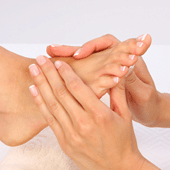WHAT A FOOT HEALTH PRACTITIONER JOB ENTAILS
What Is A Foot Health Practitioner?
A foot health practitioner job provides routine foot care and maintenance to people’s feet. It is a very rewarding job that enables you to help people in your local community and reap the financial benefits available. As part of the job, a foot health care practitioner will assess the condition of a patients feet and supply the appropriate treatment. On occasion, they may also refer clients to their G.P or podiatrist if necessary.
Most people benefit from foot care maintenance to keep their feet healthy and pain-free. The general population spend a lot of time on their feet either walking, running or standing for long periods of time. Impractical or ill-fitting footwear can also lead to feet being neglected and not maintained. Mobility and freedom to walk pain-free is extremely important to most.
Foot problems are very common and can affect people of all ages. Being elderly, overweight or diabetic increases foot problems and also the need for a foot care routine. Diabetes and obesity are rapidly increasing in prevalence in our population and the need for foot health practitioners are needed now more than ever. Foot health practitioner jobs offer a busy vocation that gives you the opportunity to grow a busy and financially viable business.
Earning Potential And Options Of An Foot Health Practitioner Job
As a Foot Health Practitioner, you have the option to work for someone or run your own business. Many Foot Health practitioner jobs are carried out on a self-employed basis either from a clinic that clients visit or as a mobile foot health practitioner whereby you visit people in their home.
If working for someone you will often find that the equipment you require will be supplied to you as part of the job role with potential to earn between £21,500 and £23,000 a year (as indicated on job search websites).
Those that choose to be self -employed and either purchase or run a surgery/clinic that clients visit can charge between £20 and £40 per client dependant on your geographical location. Overheads for rent, bills and equipment need to also be considered and clients ability to visit your premises.

Mobile Foot Health Practitioner Job
Mobile Foot Health Practitioner jobs are a popular option as overheads are minimal due to the fact you aren’t paying for a premises and only the cost of equipment, fuel and transport need to be considered. You will require a safe and sterile environment to clean and prepare your equipment and a carry case, stool and cleaning materials that can be easily transported. As a mobile Foot Health Practioner you can look to charge between £20 and £30 per client visit. Elderly clients who are either housebound or find it difficult to get out and about benefit from this option of care.
What Does A Foot Health Practitioner Do?
Foot health practitioner jobs involve offering advice to clients and treating common foot health problems such as bunions, corns and calluses. The job also involves cutting nails, removing hard skin, treating veruccas, in-growing nails and helping to prevent pain when clients are moving around. The elderly are especially prone to these conditions and benefit massively from their feet being kept in good condition. Having a kind and understanding way puts clients and ease as they entrust you with the health of their feet.
The profession combines practical care as well as giving consultations. Your key tasks as a foot health practitioner will include treating nail dystrophies, monitoring circulation and sterilising equipment to ensure everything is sterile and safe to use.

Our Mission
Private practitioners are absolutely necessary to the needs of their local communities, more so now than ever before. With long waiting lists and the low level of satisfaction expressed by many patients it is clear that local authority clinics and hospital-based departments can never meet the real needs of the population in the matter of foot health. Our services are necessary. They must be safely delivered with expertise and understanding.

Alliance Authority Accredited Register
The Alliance Authority Accredited Register for Health and Social Care sets standards for organisations holding registers for health and social care occupations and accredits those registers that meet the standards.
TESTIMONIALS
A. Glynn
"Have truly enjoyed every part of this course. Could not recommend it enough! The senior personnel are a fountain of knowledge, so inspiring! all the staff go above and beyond – we learnt with the best! "
H. Peet
"I will leave here feeling part of a family! At 45 it was worrying changing career but I honestly cannot wait. Every member of staff is a credit to the College."
E.J. Harper
"I have had an amazing time the staff and tutors are lovely. My future looks and feels a lot brighter!"
S. Price
"This course has been superb, the quick feedback on the modules was useful. The tutors and office staff were approachable and kind."
WE ARE COMMITTED TO AN EXCELLENT SERVICE & SUPPORT

THE COLLEGE & IT'S AIMS
The College is in its 19th year of successfully training practitioners to support and serve the population of the UK. It is recognised that the need of the public in foot health provision cannot be adequately met by the NHS. In addition, we believe that the public should have a genuine choice of where and when they can obtain treatment and in the nature of the treatment they can access. Foot care is absolutely essential to the maintenance of good health, and is effective in averting serious illness requiring costly intervention.

OUR MISSION
Private practitioners are absolutely necessary to the needs of their local communities, more so now than ever before. With long waiting lists and the low level of satisfaction expressed by many patients it is clear that local authority clinics and hospital-based departments can never meet the real needs of the population in the matter of foot health. Our services are necessary. They must be safely delivered with expertise and understanding.

QUALITY POLICY
This College delivers a Level 4 Diploma in Foot Health Practice - the level and delivery of which is assured by NCFE. NCFE accreditation gives assurance that the content of a training course is of a high standard and meets the rigorous quality assurance of a national awarding organisation.

Alliance Authority Accredited Register
The Authority oversees statutory bodies that regulate health and social care professionals in the UK, including the GMC, NMC and HCPC. This College is the first institution training in Foot Health Practice to offer a course that permits direct entry into an Authority Accredited Register.

